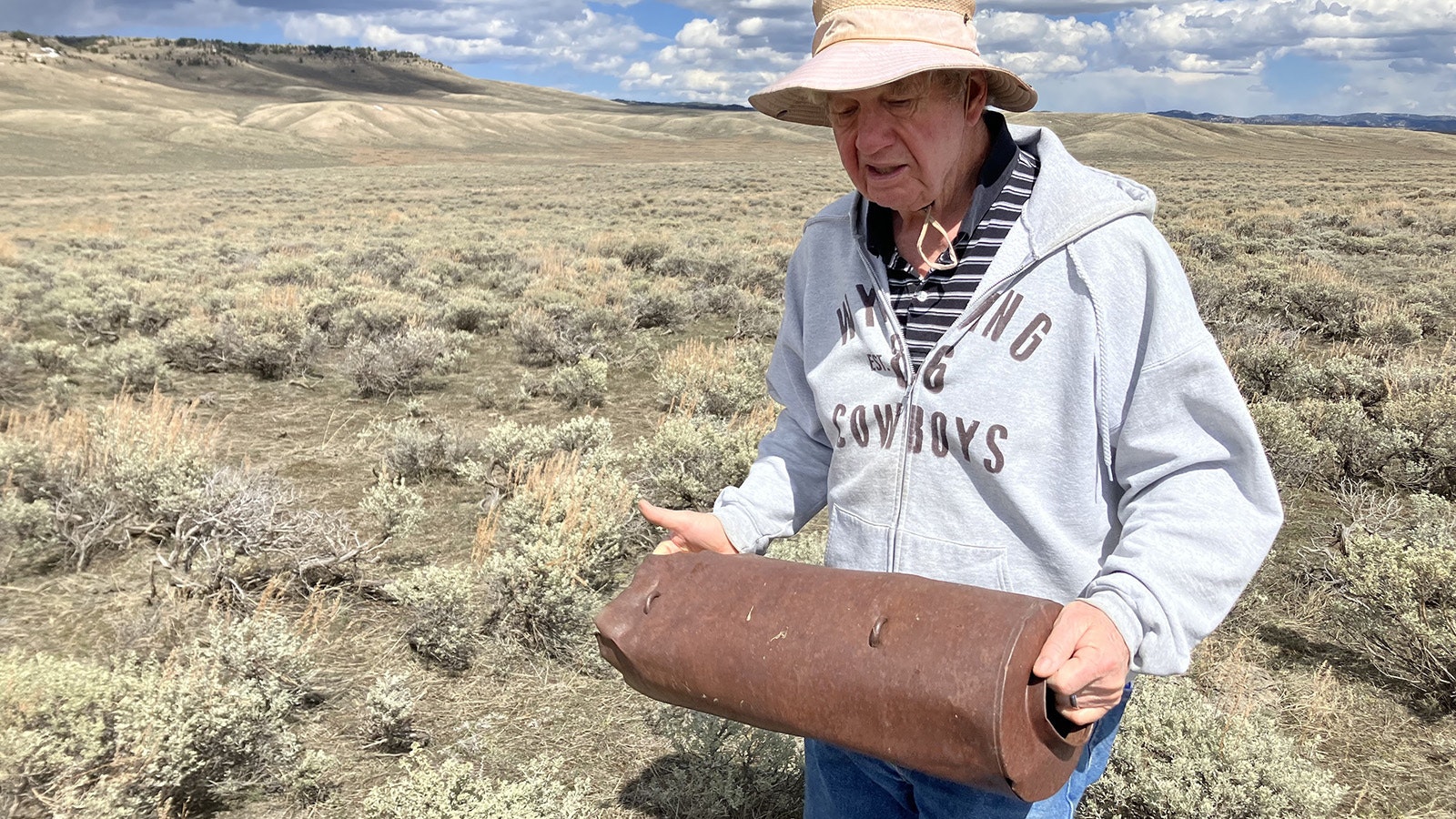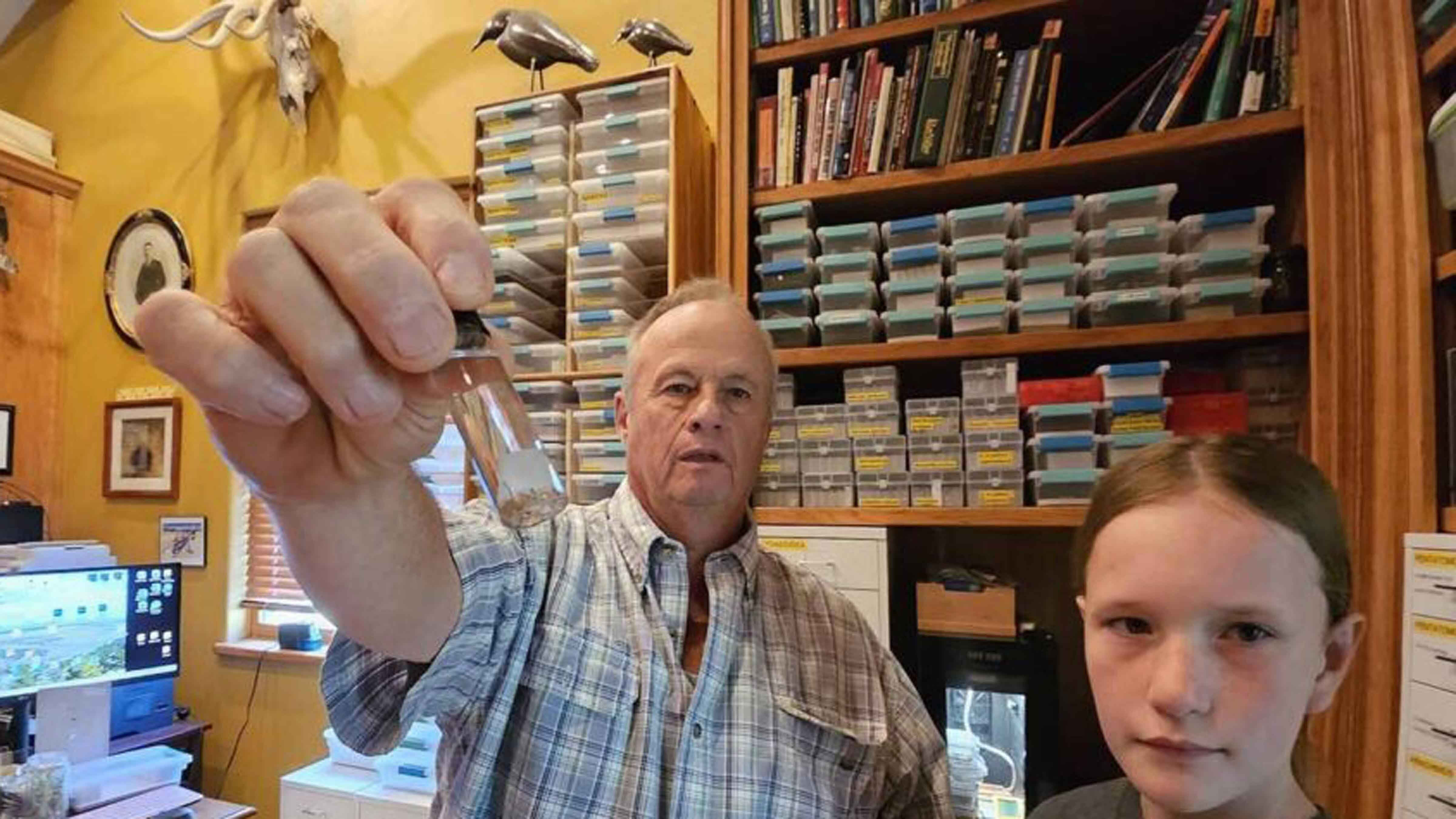On private ranch land 25 miles south of Casper, Wyoming, little pieces of aluminum and plexiglass ranging in size from about a quarter to a dollar bill mark sacred ground.
That aluminum was once in the hands of a fabricator helping put together a four-engine B-24 bomber with the numeral “59” stenciled next to its nose at the Ford Willow Run factory outside Detroit during World War II.
On New Year’s Day 1945, the Liberator bomber from Casper Army Air Base slammed into the earth in the north end of the Shirley Basin at 10:05 p.m. during a winter storm. The throttles were at cruising speed. What was whole disintegrated into fragments. The crew inside was obliterated.
The crash of Bomber 59 was one of 90 significant crashes to happen during flight training of bombers and fighter planes at Casper Army Air Base between September 1942 and March 1945.
Now eight decades later, the remains of many of those crashes are still out there to be found and pieced together.
That mission has fallen to Mark Milliken, chairman of the board for Friends of the Wyoming Veterans Memorial Museum, who searches for those lost crash sites to honor those who gave their lives preparing for battle.
The Mission
“The Veterans Memorial Museum asked us to go find these sites, this was back in 2017,” Milliken told Cowboy State Daily. “And they said the most important site is the Murchison site because it was lost and nobody had seen it since the war almost.
“Everybody was clueless when you ask about this site. So, the museum asked us to go search this one first.”
Murchison refers to 2nd Lt. Robert E. Murchison, who was the pilot in charge of the aircraft. Its crew had spent their holiday flying a mission with nine other bombers to La Junta, Colorado, and then North Platte, Nebraska. It was due back at Casper Army Air Base field at 11 p.m.
It never made it back.
It wasn’t until decades later that, after a two-year search for the aircraft, Milliken found where the plane impacted. In 2021, he invited flight crew descendants to a ceremony at the site and installed a plaque commemorating the crew’s service and memorializing the crash.
Milliken invited Cowboy State Daily to the crash site to talk about his investigation and also to look again for potential missing fragments that possibly could help narrow down the first point of impact for the bomber and its crew.
According to a Casper Herald-Tribune story on Jan. 2, 1945, the nine other bombers on the mission had landed at other airfields because of severe weather conditions. Murchison apparently tried to circle behind the storm and find his way over 8,100-foot Casper Mountain.
Milliken said the plane’s altimeter would have been showing 7,000 feet and the crew may have thought they cleared Casper Mountain. Visibility out the cockpit windows would have been difficult due to the storm and the lack of any lights on the ground to give clues about where were.
“The airplane was headed northeasterly when it crashed and it slid about 1,300 feet on the ground,” Milliken said. “So, what we are going to do today is go find the spot where it first hit the ground and then we are going to walk along the path that the airplane took while it was sliding. Keep in mind this was January and there was probably 3 feet of snow on the ground.”
The Crew
Onboard with Murchison that night were copilot 2nd Lt. Harold B. Paulk, navigator 2nd Lt. Reede l. Bludworth, bombardier 2nd Lt. Reuben J. Clark, engineer Cpl. Eugene J. Opala, and radio operator Cpl. Robert S. Hilliard.
Milliken, a retired geologist, said the crash report from 1945 had longitude and latitude for the crash, but the coordinates were incorrect. In his search for the site, he turned to a few old photos of the initial crash cleanup and was able to build a “terrain model” that he used for a search on Google Earth.
“We had a lot of wild goose chases that we had to go on. We had a lot of land we had to walk around — we had permission from property owners out there to do it,” he said. “So, we spent about a year just chasing after nothing. One the problems we are faced with is the ranchers out there had no clue where this site was.”
Then one day Milliken found a match for his terrain model based on the crash site photos, so he searched the area and found small pieces of metal.
On a sunny day last week, Milliken led the way through sagebrush at the site to a place where he stopped and turned around, hands in the air.
“Think about seeing the aircraft right here about 10 feet above our heads,” he told the Cowboy State Daily.
With eyes to the ground, here and there small pieces of debris could be seen. Milliken said the plane hit flat terrain and then skidded up a rise and finally went airborne off a 50-foot knoll into a little valley and flipped over. The plane landed on its top in a small creek at the base of a mountain.
Practice Bombs
A search of ground going up to the top of knoll found two rusted practice bombs that would have been on the plane, bits of double-paned armor in the dirt next to sagebrush would have come from the nose or a gunner ball turret. Another of small-geared metal represented a part needed to change the pitch of the propellers.
Milliken believed it likely shows where the propellers hit the earth. Father down there was a small part that may have been part of a brake line.
There are several small aluminum pieces still laying on the ground 79 years after the fact. Down by the creek, Milliken picked up two small pieces of metal that were heavy and disfigured — aluminum parts melted by fire.
Photographs of the crash site from 1945 taken from the air show the plane flipped upside down and a fairly large debris field.
When the plane failed to return, a large-scale search was launched.
The Casper Tribune-Herald printed stories Jan. 2 and Jan. 3, 1945, about the search for the wreckage that involved the Civil Air Patrol and planes from Colorado and Casper Army Air Base. On Jan. 4, the newspaper reported the wreck was found.
“A ground rescue unit has been organized and is rushing to the scene of the crash,” the newspaper reported. “However, heavy snow that covers the terrain was making travel difficult, and members of the rescue unit had not yet notified the base that they had reached the wreckage by 1:30 p.m. today.”
On Sunday, Jan. 7, 1945, the newspaper reported that the rescue crew had arrived at the site Jan. 5, 1945, four days after the crash. All the crew were dead. “Snow drifts in the area were as deep as 20 feet and the terrain was very rough,” the paper reported.
Fire Evidence
Milliken said when he and others at the museum first saw the crash photos, they assumed the crew died instantly.
“It was interesting because some of the ranchers we talked to said their grandparents rode their horses out to the crash site after it happened, after the bodies had been reclaimed,” Milliken said. “They said there was evidence at the crash site that someone may have tried to burn parts of the airplane to keep warm.”
Milliken later came across coroner reports on the crew members and said the coroner had written that two crew members froze to death.
During every walk at the crash site, Milliken said he and others who have visited try to leave it in its natural state “so we can pay homage to the crew.” Fragments of the wreck are not removed. The are put back where they’re found.
The memorial he put together in 2021 at the site included some relatives of the crew that he and others at the museum were able to track down.
“The Army National Guard came out and did a full-blown military funeral service including taps, a 21-gun salute and a folded flag ceremony,” he said. “We had 19 family members who showed up. It was a very somber, very heart-wrenching occasion. I think the families really deeply appreciated that.”
As part of the event a plaque was installed on the ground with the names of the crew members and the number of the plane. On the day of the ceremony, Milliken said when everyone walked out to the knoll and where the plaque sits above the creek and place where much of the fuselage was found, a rattlesnake was warming itself on plaque.
Family members of one of the crew remarked it was fitting, because the crewman was “always playing jokes on people.”
Since finding the Murchison crash site, Milliken has identified three others. One in Mills, one in Glenrock and a fourth south of Casper. He is cautious about sharing details because they are all on private property. Two of the sites have had granite plaques installed and a ceremony honoring the crew. Plans are in place for the next one.
“This June we will be honoring the fallen heroes of a fourth crash site,” he said.
Dale Killingbeck can be reached at dale@cowboystatedaily.com.














